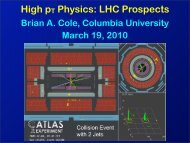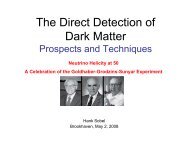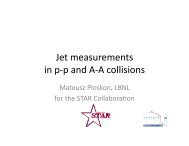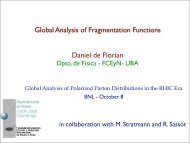One flavor QCD Abstract - BNL theory groups - Brookhaven National ...
One flavor QCD Abstract - BNL theory groups - Brookhaven National ...
One flavor QCD Abstract - BNL theory groups - Brookhaven National ...
Create successful ePaper yourself
Turn your PDF publications into a flip-book with our unique Google optimized e-Paper software.
uration, and rotate it to appear in the SU(2) subgroup involving only the first two colors. If we<br />
break the antisymmetric representation into multiplets under this SU(2) subgroup, it will consist<br />
of one singlet from both indices being in the first two colors, N − 2 doublets with only one index<br />
from the first two and finally (N −2)∗(N −3)/2 additional singlets involving only the higher values<br />
for the indices. From the instanton we expect one zero mode for each of the doublets, giving<br />
N − 2 overall. From the earlier discussion, this means the ’t Hooft vertex will involve the product<br />
of N − 2 fermion bilinears.<br />
Now consider the basic U(1) chiral rotation of Eq. (2). The ’t Hooft vertex still violates this<br />
symmetry; however, if the angle θ is chosen to be a multiple of<br />
2π<br />
N c −2<br />
, this vertex remains invariant.<br />
Thus this <strong>theory</strong> has a hidden discrete Z Nc −2 chiral symmetry. The conventional angle Θ conjugate<br />
to the gauge field topology differs from the phase of the mass term by a factor of N c − 2.<br />
This discussion assumes that all anomaly effects arise through topological structures and the ’t<br />
Hooft vertex. On the lattice one might also expect lattice artifacts to break the symmetry, much<br />
as they do for conventional chiral symmetry in the Wilson action. Even for the overlap, there can<br />
be rough gauge configurations on which the winding number is ill defined. We assume that these<br />
issues involve higher dimensional “irrelevant” operators and they disappear in the continuum limit.<br />
Turning on a complex quark mass, the <strong>theory</strong> is invariant under multiplication of this mass by<br />
an element of Z Nc −2. Thus the phase diagram of Fig. (1) must be modified to incorporate this<br />
symmetry. To be specific, consider SU(5) with the fermions in the 10 dimensional representation.<br />
(I skip over SU(4) with fermions in the 6 dimensional representation to avoid the complication of<br />
baryons being bosons made up of only two quarks.) By the above arguments the five color <strong>theory</strong><br />
has a Z 3 discrete chiral symmetry. <strong>One</strong> simple modification of the phase diagram for complex<br />
mass that incorporates this symmetry is sketched in Fig. (7).<br />
As drawn, this figure assumes that this Z 3 symmetry is unbroken. An alternative possibility is<br />
that it is spontaneously broken. In this case the three transition lines would extend to the origin.<br />
The order parameter for these transition lines is the expectation of the η ′ field, which should<br />
undergo a finite jump as one passes through them. Given the highly suppressed contributions of<br />
instantons in this <strong>theory</strong>, and in light of the smooth behavior of the three color <strong>theory</strong> when the<br />
mass vanishes, this seems rather unmotivated at small N c , but the possible alternate phase diagram<br />
is sketched in Fig. (8). It appears possible that at some large but finite N c there is a change in<br />
behavior from that exemplified by a unique vacuum and transitions not reaching the origin, as in<br />
Fig. 7, to the case where there are N c − 2 degenerate vacua at vanishing mass as in Fig. 8.<br />
24






